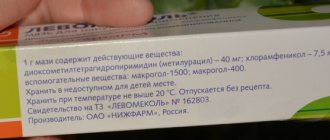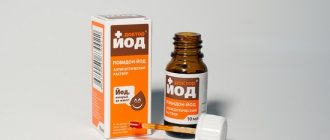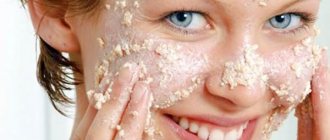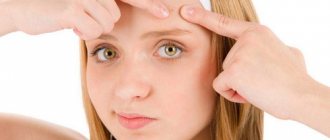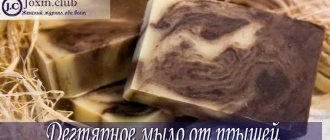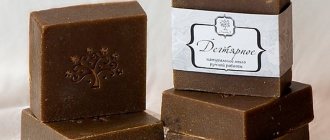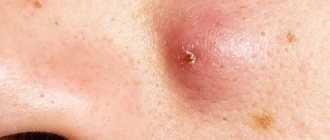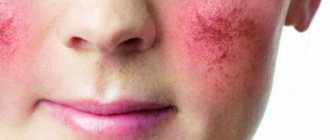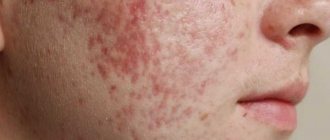Clear skin / Acne products / Other products / Iodine against acne on the face
There is probably not a single person in the world who does not know about the properties of iodine. In medicine, the drug is used very widely, since this alcohol solution actively affects various fungi, viruses, and bacteria.
Many people at different times discovered the unusual use of iodine - they burned pimples with this “corrosive” liquid . And they continue to cauterize to this day, rejecting the most modern medications.
It is not surprising that iodine for acne has many active adherents and equally ardent opponents .
You can't refuse cauterization
Is it possible to apply iodine to acne? Everyone decides for themselves. Some clear skin experts confidently state that iodine-containing preparations do not fight the problem, but only dry out the skin .
Others note: iodine actively affects an open pimple, suppressing its development . Both sides agree on one thing: when used carefully, the product is safe for the skin.
The main principle of iodine use against acne is targeted use. To cauterize point inflammation you will need:
- foam or gel for washing;
- iodine;
- cotton buds;
- cream with antibacterial effect.
You should use iodine solution to lubricate acne regularly. Under this condition, the contents of the inflammation will come out after 5-7 days.
Is it possible to burn acne with iodine?
The main factor that provokes the appearance of acne is the spread of pathogenic bacteria in the upper layers of the skin, which feed on the products of excessive work of the sebaceous glands. You can burn acne with iodine if you follow certain rules of use:
- Before cauterizing acne, your face should be washed with a mild cleansing gel to avoid dry skin;
- for cauterization, you can take a cotton swab;
- then the cotton swab is treated with iodine solution and the inflamed area is cauterized several times;
- It should be remembered that the solution leaves yellow marks, so it is best to cauterize at night or when going outside is not required.
Important! Iodine should be used precisely for acne. If you apply it as a continuous mask to your face, you can get burned.
To check the real effect of iodine, it is recommended to apply it to acne for 5-7 days. If the product is effective, the result will be visible after the first procedures. Otherwise, it is better to replace the iodine solution with a more professional product.
Iodine for Acne: Safe to Use
Iodine leaves unsightly brown marks on the skin, so it is recommended to use it at night to allow it to be fully absorbed .
Having prepared everything necessary, proceed to the “cauterization” procedure:
- Cleanse your face thoroughly. The best effect before iodine cauterization will be achieved by using mild cleansers. Regular soap will not work: dry skin is not the best springboard for targeted cauterization procedures;
- A cotton swab is generously moistened with iodine and held for 10-15 seconds in the center of the inflammation. The alcohol solution will dry out the pimples and, penetrating the epidermis, will help the accumulated pus to dissolve. The main thing is not to overdo it and not burn the skin;
- After cauterization, there will be a feeling of tight skin. It's time to use an antibacterial cream or aftershave. Moisturizer should not be used.
The manipulations performed are the main steps of using iodine against acne.
But the nature of inflammatory processes on the face is not the same. There are different types of acne :
- blackheads (comedones);
- whiteheads (millet);
- internal acne (pustules, papules).
Iodine is used in the fight against each of these species, taking into account small nuances.
If, after cauterization with iodine, the face turns red and there is a burning sensation of the skin , you need to wash your face and apply a mask of grated raw potatoes. It will absorb unabsorbed iodine and soothe the skin.
Whether iodine helps with acne under such circumstances is a rhetorical question. Cauterization will have to stop.
Iodine against blackheads
This is the same case when iodine is not recommended to be used as a “cauterizing” agent due to its absolute ineffectiveness. Pollution “sits” too deep in the pores.
For comedones, a simple lotion of water, salt and iodine will help . Half a glass of hot water is mixed with a tablespoon of salt and four drops of iodine are added.
The cooled solution is used for its intended purpose:
- a cotton pad soaked in liquid is applied to the area affected by comedones;
- a piece of polyethylene is fixed on top of the disk, which is “insulated” with a napkin or towel folded in several layers (bath effect);
- The lotion is kept for 10-15 minutes, after which the skin is wiped dry.
The procedure is repeated several times, maintaining the solution warm. After finishing the iodine-salt steaming, you can remove blackheads by lightly squeezing the skin. The epithelium is not injured.
Millet in iodine
Whiteheads are treated with iodine if the inflammation is minor . If they “grow” over large areas of the skin, irritation or even an allergic reaction may occur.
You should burn the millet with iodine spotwise at night , without touching the skin that is not affected by acne.
During the morning toilet, it is recommended to wipe the treated skin fragments with camphor or salicylic alcohol or cologne.
The procedure will facilitate the rapid release of pus from the source of inflammation and its rapid healing.
After several procedures, the skin over the grass will become thinner and open, and white balls will come out.
Iodine and internal acne
Pustules and papules are cauterized with a cotton swab in the usual way . The end of the stick is held in the center of the pimple for 10-15 seconds.
But in cosmetology this is done only for isolated foci of inflammation. In this case, foundation can be applied to the treated area of skin.
Is it possible to burn internal pimples with iodine if they are already fully “ripe”? In this case, it is better to crush three analgin tablets and pour them into a bottle of iodine .
The resulting liquid is colorless, it does not leave stains on the skin and quickly acts on acne. It should be used five times a day with the usual spot application.
If the pimple is “ripe”, you can use aloe. A piece of the plant leaf should be peeled and applied to the pimple before going to bed. After three or four procedures, aloe will draw out pus from the source of inflammation. It is smeared with a colorless iodine solution until it disappears completely.
Teenagers are not recommended to use iodine to fight acne . The cause of rashes at a young age is usually unstable hormonal levels, and not inflammation in the pores.
How to use iodine correctly
Iodine helps against acne only if it is used correctly and taking into account the characteristics of the rash. To avoid aggravating the problem, you should adhere to several rules:
- Before use, it is advisable to consult with a specialist - not every type of rash will have iodine effective;
- You should first check for allergic reactions by anointing a small area of skin on the wrist;
- before applying the solution to acne, it is necessary to cleanse the skin with foam or a special antibacterial agent; it is not advisable to use soap to avoid drying it out;
- It is permissible to use the drug only pointwise, avoiding contact with healthy skin;
- It is best to apply moxibustion at night, before going to bed, so that the iodine has time to be absorbed and there are no brown spots left on the face;
- After treating the rashes, you can apply an antibacterial cream containing salicylic acid to cope with the feeling of skin tightness; you cannot use a regular nourishing cream.
To determine whether it is possible to smear pimples with iodine without causing harm to the body, before treatment it is worth drawing several stripes on the inner surface of the thigh. If they disappear within 12-14 hours or earlier, this indicates iodine deficiency in the body, therefore, the use of the drug is not contraindicated. However, even in this case, it is undesirable to use it for more than one month.
Regular use of iodine for acne usually helps remove pus in about a week. Using the solution for a long time is not recommended, as this can lead to dry skin and other unwanted side effects.
Masks and lotions with iodine for acne
You can get rid of acne with the help of “homemade” masks. The components of the mixtures are available and many always have them at hand:
- Five drops of iodine are mixed with a teaspoon of honey, ½ teaspoon of castor oil and a teaspoon of Vaseline. The mask is applied to the skin in a circular motion and kept for about an hour;
- Mix alcohol and a five percent iodine solution in equal proportions. Treat acne, then lubricate the inflammation with calendula tincture;
- Grind two aspirin tablets, dissolve them in half a glass of water, add three drops of iodine. Before going to bed, wipe your face;
- Add three drops of iodine and two teaspoons of sour cream to a tablespoon of heated honey. Stir and apply to inflamed areas or acne. Keep the mask for 15 minutes;
- Mix three drops of iodine, a tablespoon of aloe juice and honey, and a drop of hydrogen peroxide. Apply spotwise for two to three days;
- Half a teaspoon of Vaseline is diluted in a teaspoon of nourishing cream, four drops of iodine are added. Apply a thick layer to the face for half an hour;
- Mix half a glass of vodka, egg white and six drops of iodine. Apply twice a day. After removing the mask, moisturize the skin with a rich cream.
It is not recommended to treat acne with iodine for longer than two months. It is necessary to interrupt the course for 25-30 days. Otherwise, the body will be oversaturated with the drug and a specific disease, iodism, will develop.
Is it possible to burn pimples?
There is no clear answer to the question of whether iodine can be used for acne on the face. Most dermatologists focus patients' attention on the fact that alcohol tincture dries the skin, but does not eliminate the root cause of acne and pustules. There are also those among doctors who note that iodine has an active effect on open pimples, suppressing pathogenic microflora and preventing the spread of infection.
Acne is a pustular skin disease
The main principle of treating acne with this remedy is a targeted effect. To carry out the procedure you need to prepare:
- micellar water (foam for washing is suitable);
- iodine and cosmetic sticks with cotton wool;
- antibacterial ointment.
It is necessary to smear the rashes with iodine regularly. Only by observing this condition will it be possible to get rid of subcutaneous pimples and extensive ulcers - after about a week of cauterization, the pus will come out, and the inflammation will not spread.
Pros and cons of using iodine for acne
Treatment with iodine, like any method of combating inflammation on the skin, has its advantages and disadvantages.
Pros:
- effectiveness. A couple of weeks after proper use of iodine, the effect will be noticeable. The iodine solution will eliminate pus and heal the lesion;
- cheapness and availability of the product.
Minuses:
- the ability of the product to cause an allergic reaction;
- the possibility of getting a skin burn (if iodine is used incorrectly);
- An overdose of the drug can provoke a deterioration in the general condition of the body.
Iodine is not recommended for use by women during pregnancy and children under two years of age , regardless of the location of the inflammation.
The effectiveness of iodine in the fight against rashes
Is it possible to apply iodine to acne? It really destroys pathogenic microflora and fights the inflammatory process. By drying the skin, it also to some extent reduces the amount of sebum produced, so it can help with acne. However, caution should be exercised. On the one hand, iodine tends to penetrate into the blood, so you need to keep this in mind so as not to overdo it. An overdose of this substance can lead to a deterioration in general health. On the other hand, if you get too carried away with cauterizing acne with iodine, it is quite possible to get a skin burn.
However, with adequate and reasonable use, iodine against acne is an accessible and effective remedy for some types of rashes. If you burn a pimple with iodine, a crust forms on it quickly enough, inflammation does not develop further, and after a few days the rash dries out and heals.
Side effects
Iodine is very popular and available . But its use has certain side effects and some contraindications.
Excessive saturation of the body with the drug causes so-called iodism, which has specific symptoms: bad odor when breathing and discolored oral cavity.
Acute iodism is accompanied by:
- rapid fatigue;
- involuntary muscle contractions;
- feeling of sore throat;
- vomiting;
- diarrhea
- dizziness;
- thirst.
But basically iodism manifests itself as acne. This “extra” iodine leaves the organs through the pores, causing skin inflammation.
If the source of the skin rash is unknown, it is worth considering whether it is possible to smear the acne on the face with iodine .
Unpleasant consequences can also occur if iodine gets on healthy skin. It is not recommended for use by those with dry skin prone to allergic rashes.
If you observe excessive dryness of the skin, peeling and itching after using iodine, the procedures should be stopped. In this case, iodine will not cure acne, but will only add new skin problems.
And if you burn acne caused by iodism with iodine , you can aggravate the situation and bring the allergic reaction to a very severe degree. And under such circumstances, the use of iodine-containing drugs must be avoided.
It is also recommended to seek help from specialists for internal cleansing of the body.
Modern technologies present iodine in the form of a marker (Lekker-iodine), ointment and drops (Sulfur-iodine). These forms, like regular iodine, have antibacterial, anti-inflammatory and absorbable properties.
Contraindications
In addition to the significant benefits, it is necessary to note a number of side effects that can occur if basic safety rules are not followed. In addition, there are people for whom iodine is contraindicated - these are allergy sufferers.
Allergy to iodine
People suffering from iodine intolerance sometimes experience unpleasant sensations, even if the jar of the product is simply in their field of vision. They experience nausea, vomiting, skin rashes, itching, swelling, and profuse redness of large areas of the skin. In this case, a person should completely stop using this product.
Contraindications for use
Iodine against acne on the face and other parts of the body is strictly not recommended if you have :
- high sensitivity of the body to iodine;
- pathologies of the thyroid gland;
- tuberculosis;
- diathesis;
- some skin diseases.
Most of the contraindications have been identified with the internal use of iodine, but it is better to be safe. The ability of the drug to be absorbed into the body through the skin is low - no more than two percent, but it still exists.
The effect after using iodine will not be immediate; the foci of inflammation will have to be cauterized repeatedly. However, literally a day after cauterization, the pimples will dry out and crusts will form. After another couple of days, the wounds will begin to heal. The period that clearly shows how iodine works is a week.
However, the use of iodine does not always pay off . This is possible if acne signals disruptions in the body's functioning. Only a competent specialist can help get rid of them.
The use of iodine for various types of rashes
Before deciding whether it is possible to burn pimples with iodine specifically in your case, you should accurately determine their type: the use of this remedy will not always be justified.
"Prosyanki"
If you have small whiteheads on your face, iodine will only help with small areas of inflammation. They are cauterized carefully using a cotton swab. You should hold it near the pimple for no more than 10-15 seconds to avoid burns. After a few days, the skin over the pimple will dry out, become thinner, and the purulent contents will be able to come out, after which the inflammation will gradually begin to heal.
Comedones
Blackheads and areas of skin that are inflamed due to clogged pores cannot be dealt with by cauterization, but you can use a special solution for compresses. Cotton pads are soaked in water mixed with sea salt with the addition of a few drops of iodine and applied to the inflammation. Place a plastic layer on top and cover with a napkin. Keep for about 15 minutes, after which wipe the skin well. The solution is used hot. After several procedures, when the skin is steamed, the contents of the acne easily come to the surface with gentle pressure, without damaging the epithelium. You can also use a solution based on it instead of iodine - “Lugol”.
Subcutaneous acne
Iodine mixed with analgin tablets ground into powder will help with subcutaneous acne. This product will not only cope with pathogenic microorganisms, but will also not leave brown marks, since the tablets will discolor the solution. However, it will be effective only for small foci of rashes and for sufficiently “ripe” pimples. To more effectively draw out the purulent contents from such an eel, you can use aloe leaves, peeled from the outer layer.
How to properly use the solution for dermatoses
Iodine leaves unsightly brownish spots on the surface of the skin. Therefore, it is best to apply it to acne at night. If a person has iodine deficiency, there will be no trace left of the stains in the morning. It is necessary to treat acne with iodine in the following order:
- Before cauterizing ulcers, it is necessary to thoroughly clean the skin. The best option is to use micellar water or mild cleansers. You cannot wash your face with soap - its components dry out the skin;
Iodine is intended for treating the skin after cuts and wounds as a disinfectant
- A cotton swab is dipped into a bottle of liquid and pressed against the inflamed (subcutaneous) pimple for 15–20 seconds. This time is enough for the active components of the product to penetrate into the site of inflammation and begin to promote the resorption of accumulated pus. It is important to correctly calculate the time of acupressure so as not to dry out the dermis;
- if everything is done correctly, after the procedure there will be an uncomfortable feeling of tight skin at the site of cauterization of the formation. At this stage, acne is treated with antiseptic ointment (after-shave product). Moisturizing and nourishing products cannot be used to care for the epidermis.
These are general recommendations on how to use the solution for dermatosis. However, there are many types of rashes. The most common among them:
- superficial blackheads;
- acne;
- subcutaneous ulcers.
Iodine for acne helps regardless of the type of rash. However, it is necessary to treat dermatosis taking into account their characteristics. In addition, the product can cause allergic reactions (redness of the skin, severe burning sensation). It is not difficult to remove excess substances that cause uncomfortable symptoms. To do this, apply a mask of raw potatoes to the treated area. Starch binds molecules of the active substance, eliminating irritation. When allergies first appear, you shouldn’t wonder whether iodine helps with acne. You should immediately stop treating acne with this method.
Iodine has a disinfectant and antibacterial effect
Is it possible to smear iodine on acne?
The main factor in treating acne with iodine is the drying effect of the medicine, due to which acne loses its greasiness and heals faster. But, nevertheless, iodine has the negative property of leaving burns.
Today, dermatologists around the world still cannot come to one common decision - is it possible to smear pimples with this product or not? Some doctors claim that iodine can clear the skin faster than other medications and eliminate the problem of acne. Others tend to support the theory that iodine is one of the spreaders of infections, and therefore can cause the formation of new pimples and blackheads. In addition, excessive accumulation of this substance in the body causes acne, which is difficult to fight. And in this case, iodine not only will not help, but will also worsen the skin condition.
Other experts claim that it only dries the skin, creating a healing effect, although in contrast to this there is an opinion that it is drying the skin that promotes the opening of internal pimples and the release of ulcers to the outside.
Practice shows that iodine can help treat acne, but only in the early stages of the skin disease.
Dermatologists identify several basic rules for using iodine to combat skin blemishes:
- Strictly adhere to the dosage and frequency prescribed by the doctor;
- Use only the concentration of iodine solution prescribed by the doctor;
- Only affected areas of the skin can be lubricated with iodine. If it gets on healthy people, it can cause burns;
- Before starting treatment, be sure to test for an allergic reaction of the body;
- People whose skin is prone to relapses should not treat acne with iodine.
Before starting acne treatment with iodine, be sure to cleanse your face using special cleansers. And after applying the iodine solution, you should never use creams, otherwise they will negate all the treatment.
